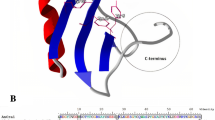Abstract
The gene encoding the BmαTX14 (α-neurotoxin TX14) protein, derived from the cDNA library of the Chinese scorpion Buthus martensii Karsch, was expressed in Pichia pastoris. The recombinant protein was purified by metal chelate affinity chromatography and gel filtration chromatography. Using patch-clamp technique, electrophysiological activity of rBmαTX14 was identified. In the neurons isolated from mice trigeminal root ganglion, the Na+ current amplitude was reduced by 80% under whole cell patch-clamp recording. There were no apparent modifications to the gating mechanism in the presence of rBmαTX14. Although BmαTX14 shared a high amino acid sequence similarity with other typical α-toxins, it has different effects on neurons. Further electrophysiological analysis suggested that rBmαTX14 selectively blocked Na+ channels and is a member of a new group of scorpion toxins.
Similar content being viewed by others
References
Deshane J, Garner CC, Sontheimer H (2003) Chlorotoxin inhibits glioma cell invasion via matrix metalloproteinase-2. J Biol Chem 278:4135–4144
Fu YJ, Yin LT, Wang W, Chai BF, Liang AH (2005) Synthesis, expression and purification of a type of chlorotoxin-like peptide from the scorpion, Buthus martensii Karsch, and its acute toxicity analysis. Biotechnol Lett 27:1597–1603
Green MW, Selman JE (1991) Review article: the medical management of trigeminal neuralgia. Headache 31:588–592
Hao CJ, Xu CG, Wang W, Chai BF, Liang AH (2005) Expression of an insect excitatory toxin, BmK IT, from the scorpion, Buthus martensii Karsch, and its biological activity. Biotechnol Lett 27:1929–1934
Kim HC, Chung MK (1999) Voltage-dependent sodium and calcium currents in acutely isolated adult rat trigeminal root ganglion neurons. J Neurophysiol 81:1123–1134
Li HM, Wang DC, Zeng ZH, Jin L, Hu RQ (1996) Crystal structure of an acidic neurotoxin from scorpion Buthus martensii Karsch at 1.85 Å resolution. J Mol Biol 261:415–431
Liu L, Simon SA (1996) Similarities and differences in the currents activated by capsaicin, piperine and zingerone in rat trigeminal ganglion cells. J Neurophysiol 76:1858–1869
Lu M, Wang K, Cao ZJ, Jiang DH, Mao X, Li WX (2005) Genomic DNA sequences and functional expression, purification of BmαTX14 neurotoxin from Scorpion Buthus martensii Karsch. Sheng Wu Gong Cheng Xue Bao 21:853–857
Pang SZ, Oberhaus SM, Rasmussen JL, Knipple DC, Bloomquist JF, Dean DH, Bowman KD, Sanford JC (1992) Expression of a gene encoding a scorpion insectotoxin peptide in yeast, bacteria and plants. Gene 116:165–172
Peng F, Zeng XC, He XH, Pu J, Li WX, Zhu ZH, Liu H (2002) Molecular cloning and functional expression of a gene encoding an antiarrhythmia peptide derived from the scorpion toxin. Eur J Biochem 269:4468–4475
Possani LD, Merino E, Corona M, Bolivar F, Becerril B (2000) Peptides and genes coding for scorpion toxins that affect ion-channels. Biochimie 82:861–868
Ramirez-Dominguez ME, Olamendi-Portugal T, Garcia U, Garcia C, Arechiga H, Possani LD (2001) Cn11, the first example of a scorpion toxin that is a true blocker of Na+ currents in crayfish neurons. J Exp Biol 205:869–876
Rodriguez de la Vega RC, Merino E, Becerril B, Possani LD (2003) Novel interactions between K+ channels and scorpion toxins. Trends Pharmacol Sci 24:222–227
Rodriguez de la Vega RC, Possani LD (2005) Overview of scorpion toxins specific for Na+ channels and related peptides: biodiversity, structure–function relationships and evolution. Toxicon 46:831–844
Shao F, Xiong YM, Zhu RH, Ling MH, Chi CW, Wang DC (1999) Expression and purification of the BmK M1 neurotoxin from the scorpion Buthus martensii Karsch. Protein Expr Purif 17:358–365
Zhu SY, Li WX, Zeng XC, Jiang DH, Mao X, Liu H (1999) Molecular cloning and sequencing of two ‘short chain’ and two ‘long chain’ K+ channel-blocking peptides from the Chinese scorpion Buthus martensii Karsch. FEBS Lett 457:509–514
Zhu SY, Li WX, Zeng XC, Liu H, Jiang DH, Mao X (2000) Nine novel precursors of Buthus martensii scorpion alpha-toxin homologues. Toxicon 38:1653–1661
Acknowledgements
This work was supported by the grants from the National Natural Sciences Foundation of China to Li WX, Wu YL and Cao ZJ (Number: 30530140; 30500089; 30570045), the Provincial Natural Sciences Foundation of HuBei to Cao ZJ (Number: 2005ABA116) and the Youth Chenguang Project of Science and Technology of Wuhan City to Cao ZJ (Number: 20065004116-06).
Author information
Authors and Affiliations
Corresponding author
Rights and permissions
About this article
Cite this article
Wang, K., Yin, SJ., Lu, M. et al. Functional analysis of the α-neurotoxin, BmαTX14, derived from the Chinese scorpion, Buthus martensii Karsch. Biotechnol Lett 28, 1767–1772 (2006). https://doi.org/10.1007/s10529-006-9155-y
Received:
Accepted:
Published:
Issue Date:
DOI: https://doi.org/10.1007/s10529-006-9155-y




